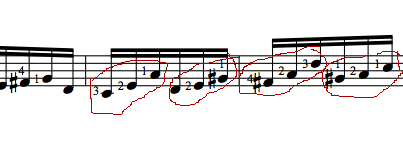Harmonic Rhythm
Harmonic rhythm is the idea that a piece has a certain rhythmic level at which the harmonies move. Most of this time this is kind of an up in the air concept as it really depends on the persons ear. If one hears it as a chord every beat, then they should analyze or label the chords for every beat. But if it’s heard as every two beats or one chord a measure that’s how it should be anlyzed.
Dealing with Non-chord tones
In real music (not musical examples) there are often tones that simply “don’t belong” with a collection of pitches. For instance in a chord or measure with an A minor chord (pitches A C E) the note B would not belong, yet it’s there.
We have a few choices in dealing with non chord tones. The first is that they can be viewed as ornamentation: notes that exist as appoggiaturas or passing tones or suspensions or neighbor tones. However, it’s really tempting, if music is highly ornamented, to consider a collection of “non chord tones” as an independent chord and label it as such. Harmony textbooks love this second explanation. Which is why many spend whole chapters talking about “passing 6/3 or 6/4” chords, which are chords without harmonic function but as supposed to be labeled “P6/3” because they are chord. I’m more inclined to just call things like that passing tones.
The Implications of Harmonic Rhythm
Your view on harmonic rhythm can have a pretty big effect on how you play something. For instance, if you view a tone a certain way it could be an appoggiatura which would change the way your phrase that particular note. Or if you view it as a part of a new chord, that implies something else. Also has an effect on fingering. This is extremely hard to talk about in an abstract, so let’s look at a really interesting portion from the Prelude of Bach’s third lute suite.
It’d be really easy to a harmonic analysis where we grouped the notes into chords like this:

This is okay, but I have some problems with it. First, the piece if felt in one, which has implications for harmonic rhythm (1 chord/measure). Second, grouping the notes like this put an accent on the first note of each group throwing the piece out of 3/8 and into 6/16 (groups of three instead of groups of two). I’m more inclined to view this particular excerpt as one chord in each measure:

This interpretation puts one chord in each measure, and views the last 16th note as a pickup into the next measure. But it does leave us with a few problem notes (circled):

The D and G# are notes that I view as lower neighbors. Because they are arrived at by leap the get a slight accent naturally, so they could really be called appoggiaturas. Interpretation-wise this means we have to downplay that accent on D and G# to keep it from sounding like the first grouping (three notes).
Harmonic rhythm and how you view it in a piece you’re performing can have a major effect on the interpretation.


paul
Hi Chris,
Top of my head, sitting in bed I’d be tempted by a dotted 1/8th, 1/16th. 1/8th – c..d,e./fsharp..gsharp,a lots of forward movement. Can’t remember what I did when I played it – it’s a long time ago. But interpretation is, as we say in England, the dog’s bollocks. [aka cat’s whiskers.]
Cheers, Paul.